 Mysteries
Mysteries  Mysteries
Mysteries  History
History 10 Surprising Stories About the Texas Rangers
 Humans
Humans 10 Philosophers Who Were Driven Mad by Their Own Theories
 Miscellaneous
Miscellaneous 10 Video-Game-Worthy Weapons and Armors from History
 Weird Stuff
Weird Stuff 10 Psychics Who Accurately Predicted Wartime Events
 The Arts
The Arts 10 Pieces of Art Inspired by a Broken Heart
 Health
Health 10 Science Fiction-Sounding New Medical Treatments
 History
History 10 Surprising Facts About the Father of Submarine Warfare
 Space
Space Ten Astonishing New Insights into Alien Worlds
 Weird Stuff
Weird Stuff 10 Bizarre Summer Solstice Rituals Still Practiced Today
 Mysteries
Mysteries Top 10 Haunting Facts About the Ghost Ship MV Alta
 History
History 10 Surprising Stories About the Texas Rangers
 Humans
Humans 10 Philosophers Who Were Driven Mad by Their Own Theories
Who's Behind Listverse?

Jamie Frater
Head Editor
Jamie founded Listverse due to an insatiable desire to share fascinating, obscure, and bizarre facts. He has been a guest speaker on numerous national radio and television stations and is a five time published author.
More About Us Miscellaneous
Miscellaneous 10 Video-Game-Worthy Weapons and Armors from History
 Weird Stuff
Weird Stuff 10 Psychics Who Accurately Predicted Wartime Events
 The Arts
The Arts 10 Pieces of Art Inspired by a Broken Heart
 Health
Health 10 Science Fiction-Sounding New Medical Treatments
 History
History 10 Surprising Facts About the Father of Submarine Warfare
 Space
Space Ten Astonishing New Insights into Alien Worlds
 Weird Stuff
Weird Stuff 10 Bizarre Summer Solstice Rituals Still Practiced Today
Top 20 World-Famous Animals
There is a special bond that exists between animal and human. Studies have shown that human to animal contact will reduce characteristics of stress and lower levels of blood pressure, heart rate, respiratory rate, anxiety, and tension. People will not tolerate animal cruelty or abuse. In the last 150 years, a large number of animals have made their mark on history. In times of war, humans and animals have worked together to defeat a common enemy. This article will examine twenty world famous animals.
It was difficult to highlight only 20 animals with so many options. There are literally thousands of creatures that could have been used. Some honorable mentions include Adwaita, who was a male Aldabra giant tortoise that lived in the Alipore Zoological Gardens until he died in 2006. At the time of his death, Adwaita was estimated to be around 255 years-old, which makes him the oldest tortoise of modern times. Heather the Leather was a 50 year-old scaleless carp. Before her death in 2010, she was described as “Britain’s most famous fish.” Heather was one of the oldest and largest carp in Great Britain and weighed 52 pounds (24 kg).
Mancs was a male German Shepherd Dog that was the most famous rescue dog in the history of Hungary. Crème Puff was a female cat that is the oldest ever recorded. She died in 2005 at the age of 38 years and 3 days. Huaso is a horse that set the high jump world record on February 5, 1949, by jumping 2.47 m (8 ft 1 in) in Viña del Mar, Chile. Huaso’s record remains one of the longest-running unbroken sport records in history. Karvardi was a bull and the champion of nelore. Fukutsuru was a Wagyū bull that helped grow the U.S. Kobe beef market. Little Yellow Jacket is the most successful riding bull in the history of the Professional Bull Riders (PBR) Association.
In the past couple years, a large number of animals in German zoos have made international headlines, including Knut, Flocke, Paul the Octopus, and Heidi. Heidi was a cross-eyed North American opossum that was given to the Leipzig Zoo by Denmark’s Odense Zoo in May 2010. Heidi was originally raised at a wild animal sanctuary in the U.S. state of North Carolina after being abandoned. In 2011, she was placed at the Leipzig Zoo in a tropical wildlife exhibit. Heidi lived alongside two other opossums at the zoo, which is a bit unusual because opossums are solitary and nocturnal animals.
Heidi’s eye condition did not affect her health, but did make her vulnerable in the wild. After photographs of Heidi were published on the Internet, she quickly became one of the most popular members of the Leipzig Zoo. Heidi inspired a popular YouTube song, a line of stuffed animals, and gained over 332,963 followers on Facebook. Before her death, she had three times more Facebook admirers than German Chancellor Angela Merkel.
In 2011, Heidi received an offer to appear at the 83rd Academy Awards via video broadcast. Instead she appeared on Jimmy Kimmel Live in a series of pre-taped vignettes, in which she predicted the winners of three Oscar categories. In September of 2011, it was announced that “The cross-eyed opossum Heidi had closed her eyes forever.” Heidi was euthanized by the zoo on September 28, 2011 after suffering from an unspecified health condition. Sadly, it was not the first time that a famous German animal has died prematurely; both Knut (polar bear) and Paul the Octopus died very young.
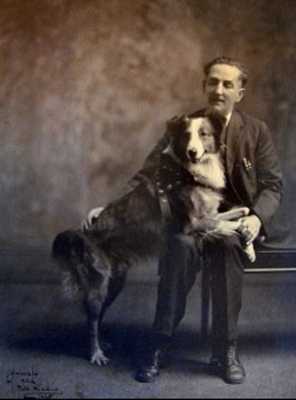
In 1923, Bobbie traveled with his family from Silverton, Oregon to Indiana. He was a two year-old Scotch Collie/English Shepherd mix. During the vacation, Bobbie was separated from his owners and became lost. After an exhaustive search, the family could not find their dog and was forced to return home to Oregon. Six months later, in February of 1924, Bobbie appeared on the doorstep of his home in Silverton. He was extremely skinny, dirty, and weak. His feet were worn to the bone and Bobbie had walked 2,551 miles (4,105 km) across the United States to return home.
During the voyage, Bobbie covered huge plains, desert, and mountains. His story quickly spread around the country. People from all over the world started to send Bobbie letters and he was given the nickname Bobbie the Wonder Dog. He was featured in newspaper articles, books, and film. Bobbie was given a jewel-studded harness and collar. At one show in Portland, Oregon, Bobbie attracted a crowd of 40,000 spectators. In 1927, Bobbie the Wonder Dog died at the age of six. He was buried with honors at the Oregon Humane Society’s pet cemetery in Portland. A week after Bobbie’s death, the famous German Shepherd Rin Tin Tin laid a wreath at his grave.
Many articles have featured the story of Oliver, who was a common chimpanzee that displayed some human-like characteristics. In the 1960s, Oliver was acquired by trainers Frank and Janet Berger and raised in their home. He was an unusual looking chimp and had a flatter face. Oliver was habitually bipedal and did not walk on his knuckles like other apes. In 2006, he was the subject of a Discovery Channel documentary in which Janet Berger claimed that by the time Oliver was 16, he had become sexually attracted to her, so she was forced to get rid of him.
Oliver was then sold to Ralph Helfer, who owned a theme park called Enchanted Village in Buena Park, California. He was displayed at the park in a show that labeled Oliver a human-ape hybrid or possible new sub-species. In 1982, his unusual characteristics were featured in a Los Angeles Times article and he was later transferred to a scientific and cosmetic testing facility. In 1998, Oliver was sent to a spacious, open-air cage at Primarily Primates in Bexar County, Texas. His DNA was tested by a geneticist from the University of Chicago, who reported that Oliver had a normal chromosome count for a chimpanzee. Oliver’s bizarre cranial morphology, ear shape, freckles, and baldness are said to fall within the range of variability exhibited by the Common Chimpanzee.
On June 2, 2012, Oliver died peacefully in his sleep at Primarily Primates. He was at least 55 years old, with the average lifespan for a male chimp in captivity being 35. Africa’s oldest known chimpanzee was Gregoire, who died in 2008 at the age of 66. After his death, Oliver’s handler responded with the quote: “He was just on a different level. He had very humanlike traits. He loved coconut sorbet and that food got the biggest hoots and hollers. But if he didn’t like something, he’d hand the bowl back to you, like the time he tried sugar-free pistachio pudding.” After his death, Oliver’s body was cremated and his ashes were spread over the grounds of Primary Primates. In 2011, the character of Caesar in the movie Rise of the Planet of the Apes was based on Oliver.

In 1943, Smoky was born in an unknown location. She was a Yorkshire Terrier, which is an extremely small breed of dog that was originally developed in Yorkshire, England to catch rats in clothing mills. In February 1944, Smoky was found by an American soldier in an abandoned foxhole in the New Guinea jungle. She was only 4 pounds (1.8 kg) and stood 7 inches (180 mm) tall. It was initially thought that Smoky was a Japanese war dog, but she did not understand commands in Japanese or English. For the next two years, Smoky back-packed through the jungle with Corporal William A. Wynne.
Smoky slept in Wynne’s tent and she shared his rations. Smoky served in the South Pacific with the 5th Air Force and participated in 12 air/sea rescue and photo reconnaissance missions. She survived 150 air raids on New Guinea and made it through a typhoon at Okinawa. Smoky even parachuted from 30 feet (9.1 m) in the air, out of a tree, using a parachute made just for her. In 1944, Yank Down Under magazine named Smoky the “Champion Mascot in the Southwest Pacific Area.” Her largest contribution to the Allied forces was with her incredible hearing and sense for danger. On multiple occasions, Smoky saved the life of Wynne and warned soldiers of incoming fire.
In 1944, Smoky made national headlines when she helped engineers build an airbase at Lingayen Gulf, Luzon. During the construction, a Signal Corps team needed to run a telegraph wire through a 70-foot-long (21 m) pipe that was 8 inches (200 mm) in diameter. Wynne attached the line to Smoky and she got the job done. According to an Animal Planet investigation, Smoky was also the first war therapy dog on record. At the end of World War II, Smoky was smuggled back into the United States hidden in a modified oxygen mask carrying case. After her return, Smoky became a national celebrity and performed her skills for crowds, which included walking a tightrope while blindfolded. On February 21, 1957, Smoky died unexpectedly at the age of approximately 14.
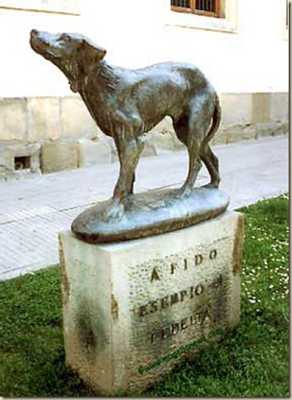
During World War II, a huge number of dogs were killed in military attacks. People’s pets were forced to flee their families and live on the streets. One of the most famous street dogs from World War II is Fido. Fido is a Latin word that means “faithful one.” In November 1941, on his way home from the bus stop, a brick worker in Borgo San Lorenzo, which is in the Tuscan Province of Florence, Italy, found Fido lying injured in a roadside ditch. Not knowing who the dog belonged to Carlo Soriani took him home and nursed Fido back to health.
After Fido recovered, he followed Soriani to the bus stop every day and watched him board the bus for work. When the bus returned, Fido was always there to greet Soriani with great joy. The pattern repeated for two years until December 30, 1943, when Borgo San Lorenzo was subjected to a violent Allied bombardment and many factories were hit. Thousands of people were killed, including Carlo Soriani. Despite his friend’s death, Fido returned to the bus stop looking for Soriani every day for fourteen more years (more than 5,000 times).
People began to notice the dog and he became a media sensation in Italy. Fido came to symbolize extreme loyalty. He died on June 9, 1958, while still waiting for his master. The news of his death was announced by multiple newspaper articles. Fido is not the only dog to have become famous for public acts of extreme dedication to an individual person. Some other dogs have showed their ending love include Hachikō, Shep, and Greyfriars Bobby.
![Donald-Y-Gua[3]](https://listverse.com/wp-content/uploads/2012/08/donald-y-gua3.jpg)
Gua was born on November 15, 1930 in Havana, Cuba. On May 13, 1931, she was donated to the Yerkes Regional Primate Research Center in Orange Park, Florida. The center specialized in the study of chimpanzees. At the age of 7 1/2 months Gua became the first chimpanzee to be used in a cross-rearing study when she was taken to the home of scientists Luella and Winthrop Kellogg and placed alongside their 10 month old child Donald. The goal of the experiment was to give Gua the same environmental advantages as Donald and then compare the similarities/differences between the two.
For nine months, the Kelloggs recorded the development of Gua and Donald. Gua often tested ahead of Donald in reading and understanding. She learned to walk faster and used a cup and spoon before Donald. The two differed in their perception of human recognition. Gua recognized people from their clothes and their smell while Donald recognized them by their faces. In physical tests, Gua performed better at jumping, climbing, and at using her feet. However, the two were similar in overall strength at such a young age. As they matured, Gua would become much stronger.
By the age of 16 months, Donald was starting to communicate, but Gua could not speak. After nine months the experiment was stopped when Donald started to copy the vocalizations made by Gua. She was eventually returned to the primate center in Florida. Gua died on December 21, 1933 from pneumonia and was only 3 years-old. Sadly, in 1972, the human subject Donald Agger Kellogg committed suicide.
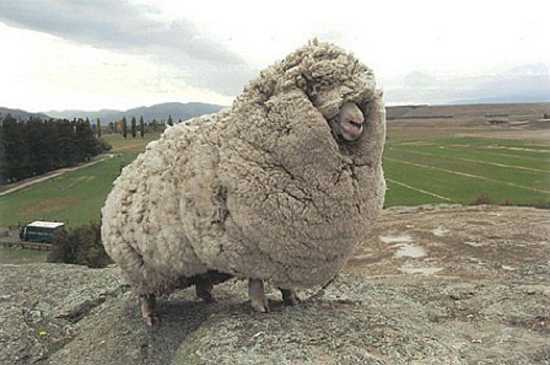
In 1994, Shrek, who is a Merino male sheep, was born in Bendigo Station near Tarras, New Zealand. In 1998, Shrek decided to leave Bendigo Station and enter the high country of Central Otago on the South Island. For six years, Shrek lived off the land. In the winter, he had little to no food available, but survived. In 2004, Shrek was found hiding in a rock cave near the Bendigo high country ranch by a team looking for sheep. When discovered, the workers could hardly believe the sight of the sheep. He had avoided being sheared for six years, which is normally an annual process for a male Merino.
Shrek was practically unrecognizable. The wool covered over 75% of his body and his fleece contained enough wool to make suits for 20 men. It total, Shrek’s coat weighed 27 kg (60 lb), with an average Merino fleece weighing around 4.5 kg (9.9 lb). Merino sheep are known for having some of the finest and softest wool in the world. Due his abnormal size and fun attitude, Shrek was named after the television ogre.
In New Zealand, where sheep outnumber people by more than 10-1, Shrek became a major celebrity. He was taken to the parliament to meet the New Zealand Prime Minister and became a national icon. A few days after his capture, Shrek’s shearing was broadcast live on national television. It took a professional shearer 20 minutes to cut the 60 pounds of wool from his body. The giant fleece was auctioned off for children’s medical charities. After the event, Shrek became a hero and raised over 150,000 dollars for kids. “He had an unbelievable personality. He loved children and was really good with the elderly in retirement homes.” Sadly, Shrek was euthanized on June 6, 2011 on the advice of a veterinary surgeon. He was 16 or 17 years-old.
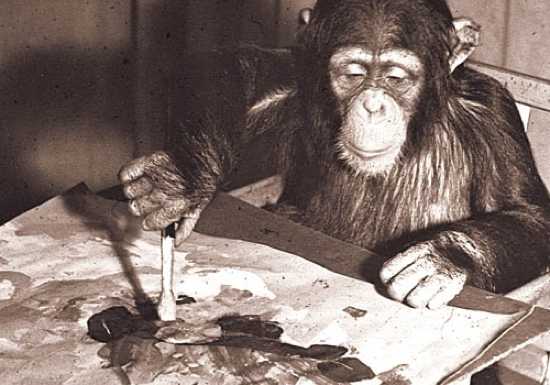
Congo was a chimpanzee that is considered the greatest animal painter in history. He was born in 1954 and produced about 400 drawings and paintings between the ages of 2 and 4. His artwork provoked strong reactions during the 1950s, ranging from scorn to skepticism. Pablo Picasso was a big fan of Congo and had one of his paintings displayed in his studio. In the late 1950s, Salvador Dali saw one of Congo’s canvasses and gave the famous quote: “The hand of the chimpanzee is quasi-human. The hand of Jackson Pollock is totally animal.” The artwork of Congo falls under the category of abstract impressionism, which is similar to Jackson Pollock.
Congo was a natural artist and understood the notion of color balance and scrubbing. He was a purist and could make unique pigments. If his art was taken away before he considered it complete, Congo would scream and throw a fit. Also, if the ape considered one of his drawings to be finished, he would refuse to continue painting even if someone tried to persuade him to do so. Congo is one of the best selling animal artists in history. On June 20, 2005, three of his paintings were included in an auction at Bonhams alongside works by Renoir and Warhol and were sold for more than US$26,000. In 1964, Congo died of tuberculosis at the age of ten.
In 1991, Wheely Willy, who was a Chihuahua, was born in Long Beach, California. From a very young age he was abused by his owner, who attempted to murder him. Willy was found inside a cardboard box with spinal injuries and a cut throat. He was taken to a veterinary hospital and saved, but Willy would never walk again. He was nicknamed Chilly Willy, because before his hair grew back, he shivered all the time. Willy was eventually adopted by groomer Deborah Turner, who did everything she could to make him happy.
In one case, Turner tried to help Willy walk by attaching a large helium-filled balloon to his hindquarters and putting him on a skateboard, but the experiment had little success. When K-9 Carts became commercially available, Willy was fitted with one of the smallest models. He adapted quickly to the cart and could move around with ease. His story caught the attention of local media and Willy became a national celebrity. He was featured on the Animal Planet television network and multiple talk shows.
Wheely Willy became a model for people with physical disabilities and made frequent public appearances promoting mutual understanding. He traveled the world and visited hundreds of hospitals to make children feel better. He was extremely popular in Japan. When Willy met Prince Hitachi and Princess Hanako, the royals got down on the floor to greet him, which caused a minor sensation in Japan.
Willy became the subject of two bestselling children’s books. He had a great personality and was an inspiration for everyone he touched. Sadly, on December 22, 2009, Willy died from injuries he sustained after Turner slipped on her porch and Willy fell out of her arms. He was 18 years-old. Wheely Willy’s message will not be forgotten: “Life is what you make of it.”

The battleship Bismarck was one of the Germans largest vessels during World War II. It was used in only one offensive operation, in May 1941, when the ship was sent to raid shipping routes from North America to Great Britain. During the voyage, the Bismarck was detected by Allied forces and attacked during the Battle of Denmark Strait. During the fight, the Bismarck destroyed the British battlecruiser HMS Hood, which spurred a relentless pursuit of the vessel by the Royal Navy.
On May 27, 1941, the Bismarck was spotted by a pair of British destroyers and sunk. In total, 2,200 German soldiers were on the ship when it went down and 115 people (1 cat) survived. The surviving cat was a black and white patched cat named Unsinkable Sam (Oscar), who was discovered floating on a board by British troops. He was the only survivor found by the British destroyer HMS Cossack.
For a couple months, Sam served on the HMS Cossack and provided the crew with moral support. He was known to walk on the ships rails with ease and was a friendly cat. On October 24, 1941, the Cossack was severely damaged by a torpedo fired by the German submarine U-563. In the attack, one third of the forward section of the ship was destroyed and 159 crew members died. Sam survived the explosion and was brought to the shoreline of Gibraltar. He was then transferred to the aircraft carrier HMS Ark Royal, which coincidentally had been instrumental in the destruction of the German Bismarck.
On November 14, 1941, the Ark Royal was torpedoed by the German submarine U-81 and sank 30 miles from Gibraltar. The slow rate at which the aircraft carrier sank meant that all but one of the crew could be saved, including Sam. He was found clinging to a floating plank by a motor launch and described as “angry but quite unharmed.” The loss of the Ark Royal proved to be the end of Sam’s military career and he was sent back to the United Kingdom. In total, Unsinkable Sam survived the destruction of three major vessels during World War II and died in 1955. The other ships Sam visited in 1941 the HMS Lightning and the HMS Legion were also both sunk later in the war.
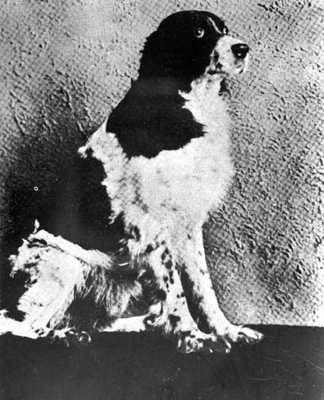
In 1925, Jim was born in Louisiana and purchased by Sam Van Arsdale. He was a Llewellin Setter, which is a strain of English setter that was bred to hunt upland game birds. The dogs are not naturally aggressive and are very smart. At a young age, Jim quickly made his mark as a great hunt dog. He was so good that Outdoor Life Magazine termed him “The Hunting Dog of the Country.” However, Jim became world famous after it was determined that he could perform some amazing acts on command.
When told to do so, Jim could go out into the street and locate a car by make, color, and license number. Among a crowd of people, Jim was able to identify the “man who sells hardware,” the “man that takes care of sick people,” and the “visitor from Kansas City.” He could understand instructions in any foreign language, shorthand, or Morse code. Jim also displayed psychic ability. If asked, he could guess the sex of an unborn baby. He picked the winner of the Kentucky Derby seven years in a row and also predicted the Yankee victory in the 1936 World Series.
After Jim was featured in the newspapers, his psychic ability was studied by psychologists from different universities. Dr. A. J. Durant, director of the School of Veterinary Medicine, tested his ability in a public demonstration and concluded that Jim “possessed an occult power that might never come again to a dog in many generations.” Journalists from all over the world came to witness Jim’s show and were stunned. His fame spread across the United States and he was featured in Ripley’s Believe it or Not. Jim died on March 18, 1937 and is buried in Marshall’s Ridge Park Cemetery in Missouri.
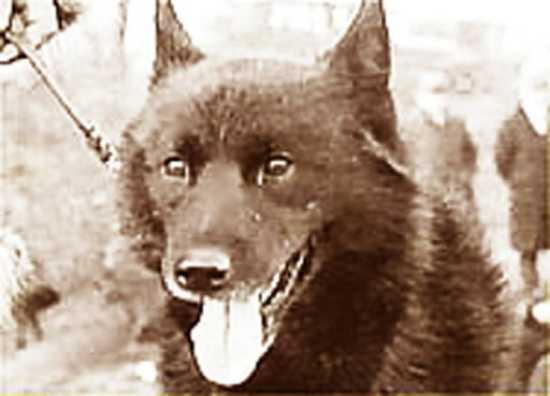
Nome is a city that is located on the southern Seward Peninsula coast of the Bering Sea. In 1924, a major diphtheria epidemic existed among Inuit in the Nome area. Diphtheria is an upper respiratory tract illness that is treated with diphtheria antitoxin. In the summer of 1924, the only doctor in the city of Nome, Alaska, was Curtis Welch. Welch ordered a new supply of diphtheria antitoxin to Nome in 1924, but it was not able to arrive before the port closed for the winter. Without the diphtheria antitoxin, the younger populations of Nome were at risk, so a massive rescue effort was carried out by sled dog teams to bring the medicine to Nome.
In total, 20 mushers and about 150 sled dogs relayed diphtheria antitoxin 674 miles (1,085 km) across Alaska in five and a half days. The serum was transported by train from Anchorage to Nenana, where the first musher started the relay. The teams all faced blizzards and extreme temperatures. After the event, both the mushers and their dogs were portrayed as heroes in the media. The most famous dog to emerge was Balto, who is named after Samuel Balto. Balto was a Siberian husky that led the final sled dog team into Nome. During his trek, Balto saved his team in the Topkok River. He was also able to stay on the trail in near whiteout conditions and worked almost entirely in the dark.
In the 1920s, Balto became the most famous canine in the world after Rin Tin Tin. To honor his achievement, a statue of the dog was placed in New York City’s Central Park. It should be mentioned that the longest and most hazardous stretch of the 1925 serum run was actually covered by a dog named Togo. Togo covered a total of 261 miles (420 km) from Nome to Shaktoolik and back to Golovin, which is much farther than Balto. Many mushers today consider Togo to be the true hero of the run. In 1973, the annual Iditarod Trail Sled Dog Race was started to commemorate the 1925 serum run to Nome.
Border Collies are often cited as the most intelligent dogs in the world. In January 2011, a Border Collie named Chaser was reported to have learned 1,022 words, and acts instinctively with human use of the words. Betsy is a black and white longhaired Border Collie that is regarded as one of the smartest animals in history. She was born in 2002 and lives in Vienna, Austria. At the age of ten weeks, Betsy was able to sit on command and retrieve objects by name. She can decipher a word after hearing it only twice.
Betsy learns in the same way that human toddlers do, if not faster. She is capable of finding the similarity between a two-dimensional photograph and the object it depicts. If you show her an image, she can find the object without any training, which displays greater intelligence than great apes. Betsy can identify 15 separate people by their name and is extremely attentive. In the last 15 years, multiple dog breeds have become smarter and more connected with humans.
It has been predicted that Betsy’s “understanding of human forms of communication is something new that has evolved. It is something that has developed in the dogs because of their long association with humans. This is not trivial, but it means that evolution can invent similar forms of advanced intelligence more than once. It is not something reserved only for primates or mammals.”
Modern scientific research has provided links between human diseases and dogs. In 2009, it was discovered that Lou Gehrig’s disease is similar to the genetic mutation responsible for degenerative myelopathy (DM) in dogs. In 2011, it was found that the same gene mutation found in Tibetan Terrier dogs can also be found in a fatal human neurological disorder related to Parkinson’s disease. Basically, researchers believe that identifying the genetic causes of cancers in dogs can lead to possible treatments for humans.

Sergeant Stubby was the first war dog used by the United States in World War I. He is noted as being the only dog to be promoted to sergeant through combat. It is unknown exactly when Sergeant Stubby was born, but he was a Pit bull breed. In 1916 or 1917, Stubby showed up at Yale Field in New Haven, Connecticut, while a group of soldiers were training. He made friends with Corporal Robert Conroy and when Conroy was deployed to fight in France, Stubby went along. Once in France, Sergeant Stubby was used for a wide range of military tasks.
He served with the 102nd Infantry in the trenches of France for 18 months. Stubby participated in four offensives and 17 battles. He was able to detect sound and smell from an incredible distance, so Stubby was used to warn soldiers of incoming mustard gas and artillery attacks. On many occasions, he saved the life of multiple men. Stubby was also able to locate and comfort wounded soldiers who were separated from the group and located in no man’s land. On one occasions, he was solely responsible for capturing a German spy in the Argonne.
Sergeant Stubby was the most famous U.S. dog used during World War I. In 1918, his exploits were front page news in every major newspaper in the United States. Stubby was wounded on several occasions during the conflict, but survived. After the war, he was smuggled back to the United States and became a celebrity. Sergeant Stubby marched in parades, met U.S. Presidents, and was named the official mascot of the Georgetown Hoyas’. He was also made a life member of the American Legion, the Red Cross, and the YMCA. In 1926, Stubby died at the age of 9 or 10. His body was stuffed and put on display at The Price of Freedom: Americans at War exhibit at the Smithsonian.
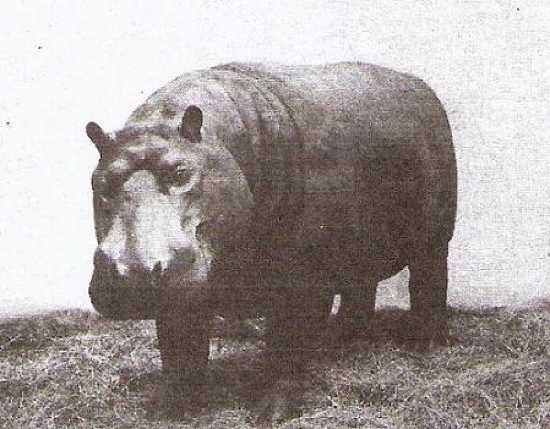
Huberta is one of the most famous hippopotamus in the history of South Africa. In November 1928, Huberta was living near a waterhole in the St. Lucia Estuary in Zululand when she decided to start a 1600 km (1000 mi) journey to the Eastern Cape of Africa. The voyage took over three years and captured the attention of huge crowds of people. She was constantly followed by curious journalists and became extremely famous. Huberta was not shy. She crossed roads, railroads, and visited towns. She ate her way through parks, gardens, and farms, and even trampled over golf courses.
During her journey, Huberta eventually settled at the mouth of the Mhlanga River for several weeks and seemed to enjoy the area. People would visit the hippopotamus and give her fruit, sugar cane, and other treats. Since she was so popular, the decision was made to try and capture Huberta and place her in the Johannesburg Zoo, but she proved elusive and the attempt failed. Huberta then traveled south to Durban where she visited a beach and country club. Due to her celebrity, the Natal Provincial Council declared Huberta royal game and it became illegal to catch or hunt her.
In March 1931, Huberta arrived in East London, South Africa. On her voyage she crossed 122 rivers. One month after arriving in East London, Huberta was shot and killed by a group of hunters. The men were tracked down and arrested. They were fined £25 for killing royal game. Huberta’s body was recovered and sent to a taxidermist in London. In 1933, the body of Huberta was returned to South Africa. The event was highly publicized and over 20,000 people came out to greet her. Huberta was eventually placed in the Amathole Museum in King William’s Town, where she remains on display so that everyone can enjoy her remarkable story.
Endal was a pedigree yellow Labrador retriever that was trained as a fully operational assistance dog. He was able to respond to hundreds of instructions and signed commands. Endal could go shopping, operate electrical switches, run an elevator, and work a washing machine. He was the first dog to use an ATM card and could put a card into the cash machine, retrieve the money, and place the cash into a wallet.
In the late 1990s, Endal became the service dog for disabled ex-Royal Navy Chief Petty Officer Allen Parton. Parton suffered serious head injuries during the Gulf War, including a 50% memory loss. Endal was assigned to Parton in order to help him with daily activities. Since he was so intelligent, Endal was featured in multiple television documentaries. He was used as the animal ambassador for service dogs and appeared at training centers and charities.
Endal soon became the most decorated dog in the world. He was named the dog of the Millennium and awarded the PDSA’s Gold Medal for Animal Gallantry. During his lifetime, Endal was filmed by over 340 crews and featured on numerous television shows in Japan, Australia, USA, Canada, Europe, and China. He has been called one of the most famous dogs in the history of the UK and was the first dog to ride on the London Eye.
In 2001, Endal received worldwide attention when it was reported that he helped save Allen Parton’s life. During the event, Parton was knocked out of his wheelchair by a passing car and left unconscious. Endal pulled Allen into the recovery position, retrieved his mobile phone, fetched a blanket, and covered his friend. He then barked for help and ran to a nearby hotel to notify the authorities. It was an amazing act of bravery. Sadly, On March 13, 2009, Endal died at the age of thirteen. He is remembered as one of the world’s greatest assistance dogs.
The Pinta Island tortoise was a subspecies of Galápagos tortoise that was native to Ecuador’s Pinta Island. They were first described by herpetologist Albert Günther in 1877. By 1900, most of the Pinta Island giant tortoises had been wiped out due to hunting. The species was also devastated by the introduction of goats, which destroyed the natural habitat. By 1971, it was assumed that the species was extinct until Lonesome George was discovered on Pinta Island.
For his safety, George was relocated to the Charles Darwin Research Station on Santa Cruz Island. For decades, multiple attempts were made to mate George with females from different subspecies, but it failed. At one point researchers offered a $10,000 reward for a suitable mate. While George was in captivity, the Pinta tortoise was pronounced functionally extinct, which made him one of the rarest creatures in the world. He was a star attraction of the Galápagos National Park and served as a symbol for animal conservation efforts.
On June 24, 2012, it was announced that Lonesome George had been found dead by his caretaker Fausto Llerena. It was shocking news because George was relatively young for his species. While his exact age was not known, it was estimated that he was about 100, which made him a young adult. The subspecies of Pinta Island tortoise can live up to an age of 200. The body of George was embalmed and he will be conserved for future generations. Today, some 20,000 giant tortoises of other subspecies live on the Galapagos.
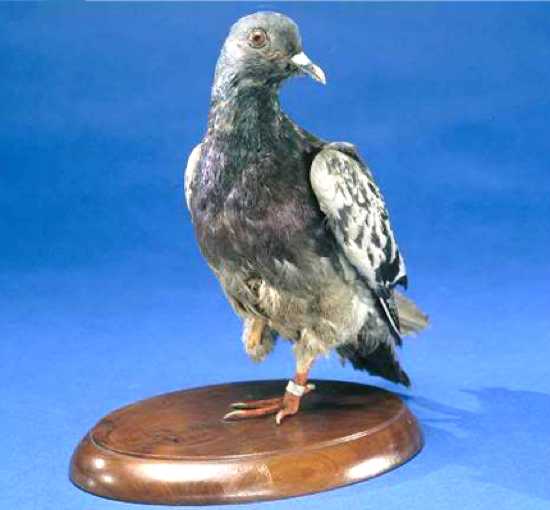
Pigeons have played an important role in the history of war. They are extremely talented military messengers because of their homing ability, speed, and flying altitude. A full article on famous war pigeons could be made, including the likes of Commando, Paddy, William of Orange, and Mary of Exeter, but I chose to focus on Cher Ami. Cher Ami (French for “dear friend”) was a Black Check Cock homing pigeon that was trained by the U.S. Army Signal Corps in France during World War I.
On October 3, 1918, U.S. Army Captain Charles Whittlesey and more than 500 men became trapped in a small depression in the Forest of Argonne behind German enemy lines. The men had no food or ammunition and were at a strong disadvantage. For over four days they were attacked by grenades, flame throwers, and waves of sniper fire, but held off the Germans. The soldiers were also beginning to receive friendly fire from Allied troops. To try and stop the onslaught, Captain Whittlesey dispatched a series of messenger pigeons, including Cher Ami.
The German troops were well aware of the pigeon’s capabilities as a messenger, so they were constantly looking to shoot them down. After Cher Ami was released, his two partners were killed instantly, but Cher Ami escaped. At one point during the voyage, he was shot in the chest and fell to the ground, but Cher Ami got up, took flight, and made it back to his loft at division headquarters 25 miles to the rear in just 65 minutes. When he arrived, Cher Ami was found with a note in a canister on his left leg that read: “We are along the road parallel to 276.4. Our own artillery is dropping a barrage directly on us. For heaven’s sake, stop it!”
Cher Ami was covered in blood and had a gunshot wound. He was blinded in one eye and his leg was hanging on by one tendon. The message delivered by Cher Ami allowed Allied troops to enter the area and save the life of 194 men. After the event, Cher Ami became the hero of the 77th Infantry Division, which was named the “Lost Battalion” by the media. Army medics worked hard to save his life, but Cher Ami lost his leg. He was fitted with a carved wooden leg and became the mascot of the U.S. Department of Service until he died on June 13, 1919, from the wounds he received in battle. To American school children of the 1920s and 1930s, Cher Ami was as well known as any human World War I heroes. His body was later mounted by a taxidermist and enshrined in the Smithsonian Institution.
The population of captive pandas has jumped considerably in the past 30 years, which is largely due to a successful breeding program. However, wild populations remain in crisis. There is no biological difference between a panda raised in captivity and those in the wild, but they can’t live together. In fact, there are very few if any examples of a bear species being bred in captivity and then being successfully introduced to the wild. This is because bears tend to be opportunistic in their use of resources and struggle to cope. Panda experts have long agreed that more research needs to be made in order to understand the lifecycle of wild pandas.
In 2006, a male panda named Xiang Xiang became the first giant panda to be returned to the wild after being bred and raised in captivity. Xiang Xiang was born in 2001 at the Wolong Giant Panda Research Center in the Sichuan Province. At a young age he endured a three year training regimen intended to equip him with the skills necessary to survive in the wild. He learned how to build a den, forage for food, and mark his territory. Xiang Xiang also developed defensive skills such as howling and biting.
Xiang Xiang was released in April of 2006 and equipped with a radio-collar to track his movements. He weighed 176-pounds (79 kilograms) and reportedly hesitated for a second when let go, but then scampered off into a nearby forest. Despite the extensive preparation, Xiang Xiang was found dead less than a year after his release. His body was discovered with multiple scratches and it is believed that Xiang Xiang died after falling from a tree. He might have been running away from other pandas when he died. According to the professionals “Xiang Xiang died from fighting for territory or over a female mate with other male pandas.”
The next potential candidate for a release into the wild might be Tao Tao, who is a male giant panda that was born on August 3, 2010 in a semi-wild training base in Hetaoping. According to the new plan, Toa Toa must excel in three different sized training fields before he can finally be released into the wild.
Marjan was the most famous resident of the Kabul Zoo in Afghanistan. In the late 1960s, the Kabul Zoo was extremely popular and held more than 500 animals, but it suffered from the violence of Afghanistan. In 1978, Marjan the lion was given to the Kabul Zoo by a group from Cologne, Germany. For 23 years, Marjan lived at the zoo and experienced intense conflict. He survived the arrival of the communist People’s Democratic Party of Afghanistan, the Great Saur Revolution, and the USSR invasion.
After the Russians left Afghanistan in 1989, a civil war ensued. The fighting left the area in total chaos and the zoo was shelled on many occasions. In 1996, a man snuck into the zoo and entered Marjan’s cage. After he tried to touch the lion, Marjan killed him. In retaliation, one of the man’s friends entered the zoo and threw three hand grenades into the lion’s cage. The explosion rendered Marjan blind, deaf, and permanently disabled. The man who threw the grenade was violently attacked and murdered a few weeks after the incident.
Once western forces moved into Afghanistan, the bad conditions of the Kabul Zoo were revealed to the world. Marjan, the blind lion, became an instant celebrity. Animal rights organizations traveled to Afghanistan to help the lion and other animals in the Kabul Zoo. Despite the overwhelming response, Marjan died in January 2002. He was given a public ceremony and buried on the zoo grounds. On his grave is posted: “Here lies Marjan, who was about 23. He was the most famous lion in the world.” In March 2002, China donated a pair of lions to the Kabul Zoo to replace Marjan.








